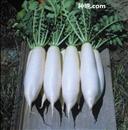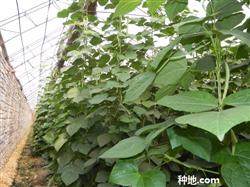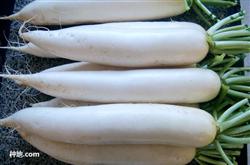How to grow high-quality white radish?

How to grow high-quality white radish? Please guide high-quality white radish to grow in this way: to choose suitable soil to grow radish should choose crops with less fertilizer consumption, more residual organic matter and no same diseases and insect pests as the previous crop. It is necessary to avoid cruciferous vegetables as the first crop, otherwise it is easy to lead to diseases. Radish has a wide adaptability to sandy soil. in order to obtain high-yield and high-quality products, it is better to use sandy soil with deep soil layer, loose soil, good drainage and fertile sandy soil. Only when cultivated in suitable soil, the fleshy root can be fully expanded, the shape is correct, the skin is smooth, and the color is beautiful. The plot requires deep ploughing and uniform fertilization, which can promote the increase of available nutrients and beneficial microorganisms in the soil, and can be loosened and ventilated, which is conducive to the absorption of nutrients and water by the roots, so that the leaf area expands rapidly and the fleshy roots expand rapidly. 75 kg ternary compound fertilizer can be applied per mu as base fertilizer. Then carry on the soil disinfection and sterilization and the control of underground pests. Fungicides use 50% carbendazim 600 times or 70% methyl topiramate 800 times 1000 times spray, insecticidal agents can choose 48% Lesbon EC 800 times 1000 times spray. The quality of sowing radish seeds has a great influence on the growth and yield of radish plants. In order to make the seedlings neat, complete and strong, seeds should be carefully selected and only full and sound seeds should be used to eliminate shriveled, broken and moldy seeds. The sowing amount depends on the quality of the seed, soil quality, climate and sowing method. Radish in autumn and winter is often sown on demand or strip. The seed quantity is determined according to the sparse density of the seedlings, the distance between the seed nests is 2530 cm, each litter is 4 seeds, and the seeds are scattered in the nest to avoid crowding after emergence and affect the quality of the seedlings. Field management should keep up with the rapid growth of seedlings after they are unearthed, and there should be time seedlings to prevent crowding, shading and overgrowth. It is necessary to set the seedlings early, divide the seedlings into different stages, and set the seedlings at the right time to ensure that the seedlings are smooth and strong. Generally, the seedlings were divided into two or three times, and the seedlings were pulled out, which were weak, deformed, and damaged by diseases and insect pests. Reasonable watering is mainly determined by the growth characteristics of radish, the requirements of water in each growth period, climatic conditions and soil conditions. After sowing, if the weather is dry, water should be watered immediately, and water should be watered again when the seedlings begin to emerge, so as to keep the ground moist, ensure neat emergence, and reduce the occurrence of virus diseases. If it is rainy, it should be drained in time to prevent dead seedlings. Scientific topdressing winter radish is a large and medium-sized radish variety with a long growth period. On the basis of applying sufficient base fertilizer before sowing, topdressing should be applied properly, especially for the land with low soil fertility and insufficient base fertilizer, topdressing can obviously increase the yield. Fertilizer should be mixed with nitrogen fertilizer and water or dung water. After the radish "broken belly", entered the peak leaf growth stage, that is, the rosette stage, in order to promote the expansion of leaf area, it is also appropriate to apply a quick-acting nitrogen fertilizer; in the peak stage of fleshy root expansion, a compound fertilizer is applied, which is helpful to the expansion of fleshy root. On the other hand, spraying 0.2% potassium dihydrogen phosphate twice a week for foliar topdressing 20 days before harvest had a good effect on improving yield and fleshy root quality. Scientific middle ploughing, weeding and pest control radish needs to loosen the soil many times during the growing period, especially in the seedling stage, the temperature is relatively high, Rain Water is more, weeds grow rapidly, and weeds should be ploughed and weeded frequently. When cultivated in high ridges, the soil on the ridges is easy to be washed away by Rain Water, which needs to be combined with soil cultivation when ploughing. Long exposed varieties of radish, because the root neck is slender and weak, often easy to bend, lodging, the initial growth needs to be cultivated to expand roots to prevent lodging resulting in the formation of curved radish. By the later stage of the rosette, the leaves had been closed and the middle ploughing was stopped, and the weeding had to be pulled out manually. The insect pests of radish are mainly aphids and soft rot, using 10 million units of 12% agricultural streptomycin sulfate wettable powder to add 50 kg of water per mu or spraying with 57.6% chlorothalonil dry granule 1000-1200 times liquid spray, combined with root irrigation. To control aphids, imidacloprid can be used to spray water. The timely harvest of winter radish depends on the variety and the time on the market. Early harvest, low yield, hardening and no taste; too late harvest of the fleshy root frozen or hollow, the quality becomes worse, resulting in hollow. It is more suitable for harvest when the root diameter is expanded to 8 cm and the length is 25 cm to 30 cm. Click for more radish planting techniques click to get more vegetable planting techniques
- Prev

How to sow and fertilize beans?
How to prevent diseases and insect pests by planting beans in greenhouse? Please introduce that planting beans in the greenhouse can be used to control diseases and insect pests in the following ways: first, bean rust symptoms: the main harm to leaves, serious harm to petioles and pods. At the beginning of the disease, there are small yellowish spots on the back of the leaves, then turn rust-brown, bulge shows a small pus scar, and then expand.
- Next

How do you grow high-quality white radish?
How are high-quality white radishes grown? Please introduce the selection of suitable soil. When planting white radish, non-cruciferous crops with less fertilizer consumption and no same diseases and insect pests should be selected as the previous crop, otherwise it is easy to cause diseases. Radish has a wide adaptability to sandy soil. In order to obtain high yield and high quality products, it is still necessary to use deep soil layer,...
Related
- Where is it suitable to grow horseradish in China? it is expected to see the middle altitude horseradish in Alishan.
- How to prevent tomato virus disease reasonably? (Control methods included)
- Many people like to plant towel gourd on the balcony. What are the main points of this method and management?
- What crops can chili peppers be mixed with?
- Fertilization techniques and matters needing attention in Tomato
- What are the grafting techniques for peach seedlings in spring?
- Harm and control methods of root swelling disease of Chinese cabbage
- What are the pests of sweet potatoes? How to prevent and cure it?
- Symptoms, causes and Control methods of navel Rot in Tomato
- The cause of "Cucumber rotten bibcock" in Farmers' planting Cucumber and its Control Plan

